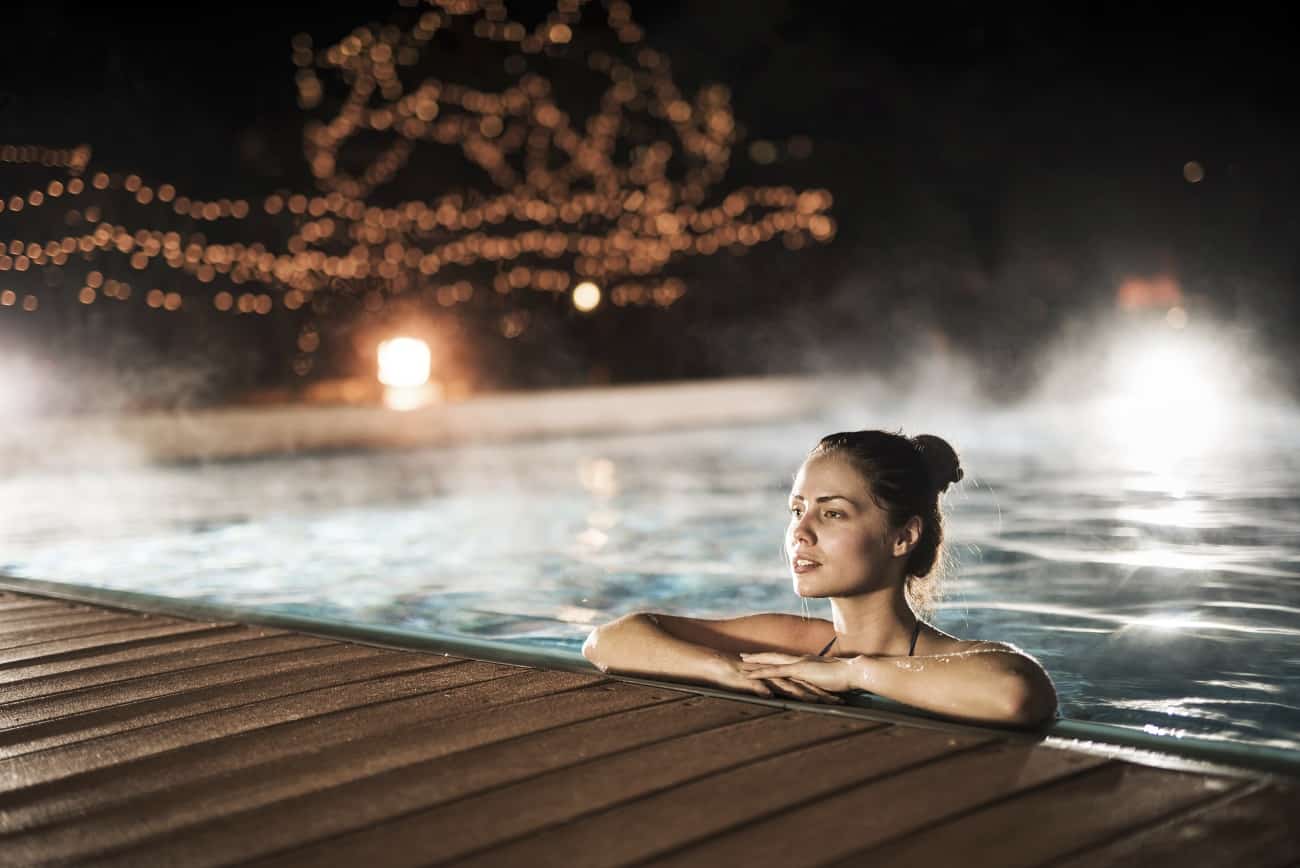
Have you installed your pool recently and are looking for an answer on how to heat a swimming pool? Is heating your pool daily an expensive task so you’re looking for a cost-effective method to heat your pool. A warm pool gives a wonderful feeling when swimming.
There are many choices and to find the ideal choice, you must keep your eyes on certain factors, such as the type and size of the pool. Or how often will you be using your pool? Some popular and effective heating systems are mentioned below.
[toc]Simple Yet Effective Ways to Heat a Swimming Pool
To heat your pool, there are some simple ways to do it, as listed below.
1. Heat Insulation
If you are planning to build a swimming pool, you can use Insulation to reduce heat loss. Insulation is used normally in thermos and hot-pots to keep the heat in. This way, your beverages or food stays hot for a long time.
In the USA and Canada, the average temperature of the ground stays the same throughout the year. It is quite lower than the ideal temperature to enjoy the pool. To keep your pool’s temperature higher, you will have to use rigid panel insulation under and around the pool base to save energy costs to keep the water hot. The insulation will create a distance between the pool and the ground. It will sustain the heat of the pool and makes sure it’s not lost.
Insulating panels will cost you more, both in material cost as well as installation. But this is the best and most foolproof way to insulate your pool. The extra bucks will be worth it.
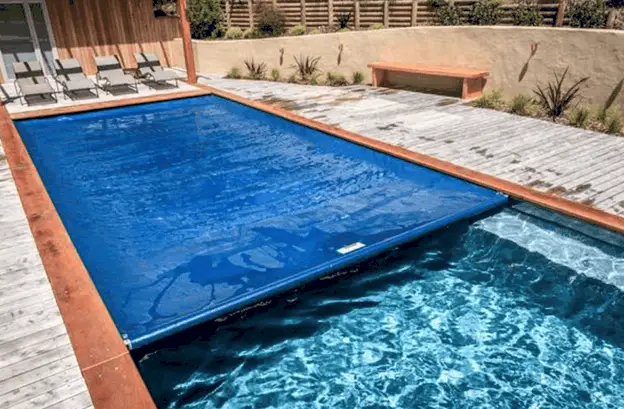
2. Burning Wood
A much more primitive and simpler way to heat the pool is to use fire. You can use firewood to start the fire and then use piping to cross pool water to heat the pool. This technique is efficient but quite expensive as you will need labor. Also, a continuous supply of wood to keep the fire on. It can only be used during special occasions for small pools.
Also, this method will have a higher material cost since you lay down an intricate system of pipes and heat exchangers. It’s your next best option after heat insulation. You can also try using heated water from your water heater, instead of heating it with burning wood. Remember the hot water supply must be continuous, as stagnant water will start to cool down.
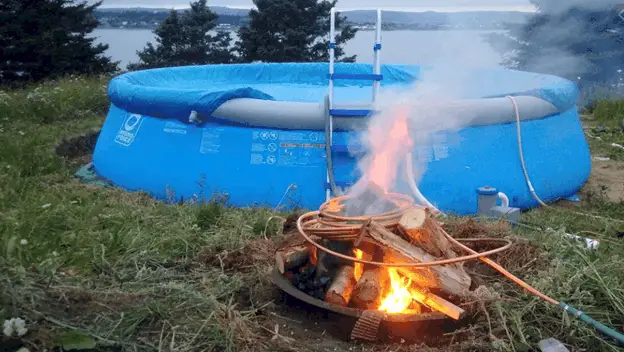
3. Black Hose
This method of working uses the heat provided by the sun to heat your swimming pool. Dark color tends to absorb more heat than a light color. And this way, with a darker hose you will be heating your water with a cost-efficient yet simple way.
Make sure that the color of the water hose is black or some dark color. Now you need to buy an extra 100-150 ft. hose for this technique. Place the remaining hose in the coiled form at a place where it will get the most heat. When you fill water through this hose, the coil formation absorbs heat, and the water will start passing through it. This way you get a warm swimming pool.
One problem with this technique is, it doesn’t provide continuous heating. You have to trust the weather to stay warm enough to not cool down the water. You can try refilling the pool every half an hour or so, but that won’t be sufficient.
Another issue with this method is, it relies on passive heating, which won’t always provide you with the best heat output. And to top it off, it won’t work at night.
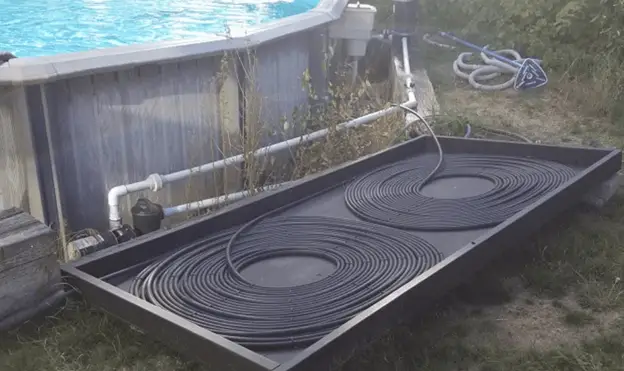
Covering Your Pool to Heat a Swimming Pool
After a water hose, with a little science, you can cover your swimming pool to keep the heat. There are some different ways to do this.
4. Solar Cover
Most of the heat of a swimming pool is lost through evaporation. Light from the sun heats the water. This water then gets to the top of the pool and evaporates into the air. The heat loss can be reduced by a simple method, to cover your pool surface with a solar cover.
A solar cover is a lid that absorbs heat from the sun but does not let the water evaporate. This way, the heat will stay inside your swimming pool with no way to escape. You can remove the solar cover whenever you want to use the swimming pool and it will be ready with warm water inside.
This isn’t the continuous heating, and if your guests are in the pool for too long, you’ll have to reheat the pool. One thing that makes it better than the hose technique is the heat will stay retained even through the night. But once you pull the cover away, you’ll have to wait till the morning to reheat the pool.
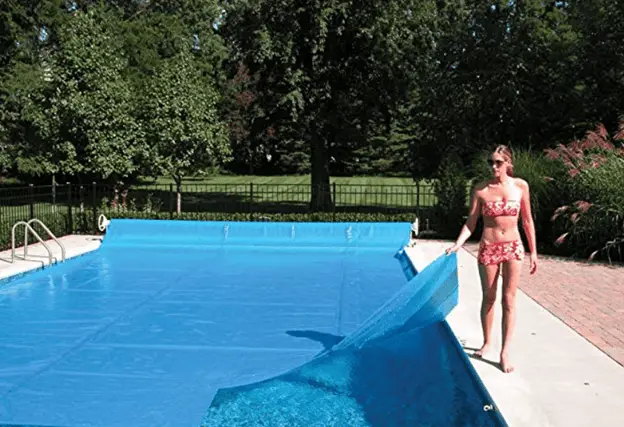
5. Solar Rings
An alternative to solar cover is solar rings. Just like solar covers, solar rings reduce the evaporation process to 10%, if not completely. They are small in size and placed all over the pool. They will start working as solar shields absorbing the heat and shifting it to the pool.
When compared to solar cover, they are easier to install and use. For a solar cover, you will have to measure the exact size and then cut it into that size. Whereas for the rings, you can just throw them in the pool to make them work.
These can also be used when the pool is in use. Although you can get continuous heat, they’re still not as efficient as solar covers.
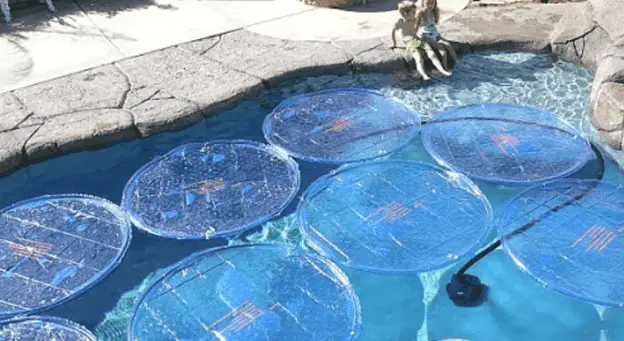
6. Liquid Solar Cover
These covers work similarly to physical solar covers. They generate a thin liquid line that covers the pool and reduces evaporation. These liquid covers are lighter than water so they always stay on top. They are eco-safe and non-toxic chemicals that won’t be an issue to your health even if you swim while using these liquid covers. These liquid covers may seem like a revolutionary invention, but they are not as effective as solid covers. They are quite useless in windy locations because wind can break the liquid seal.
The seal will also get broken if you swim too vigorously. But it’s still a handy way to continuously heat your pool with no interruptions.

7. Windproof Pool Enclosure
A windproof pool enclosure is one of the best ways to keep the heat of the pool and keep it from evaporation. Wind alters the surface area of the pool; this allows warm water of the pool to escape from it. Not only does this enclosure save your pool from evaporation, but it also makes your pool accessible during any weather. Whether it’s sunny or shiny, It is quite useful; the cost of this enclosure depends on the size of your pool. So if you have a small pool, this mode can cost less for you.
You can also pair this method with any other. It’s quite a versatile choice.
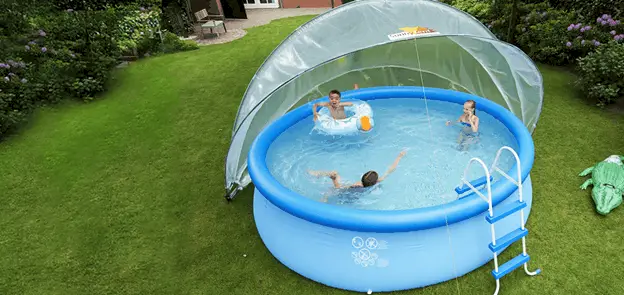
Using Sunlight to Heat a Swimming Pool
While those techniques keep the heat in your pool, you can use the sunlight and convert it using different appliances to warm-up the swimming pool. Here’s how you can do it.
8. Using Solar Panels
Solar panels are used to convert heat energy into electric energy. This electricity can then run the water heater, heat the swimming pool in minutes. It is an eco-friendly installation as will only use the energy that it generates from sunlight.
Unlike a cover for your pool, using solar panels is quite costly. And you need some knowledge of how they work to rig them up. Depending on the size of the pool, the price can increase ten-folds. That is not the only problem with solar panels. You will also need a large space to place these panels to produce enough energy for the water heater.
You can always use a regular electric heater for the water. But its running cost is higher than the solar-powered heater.
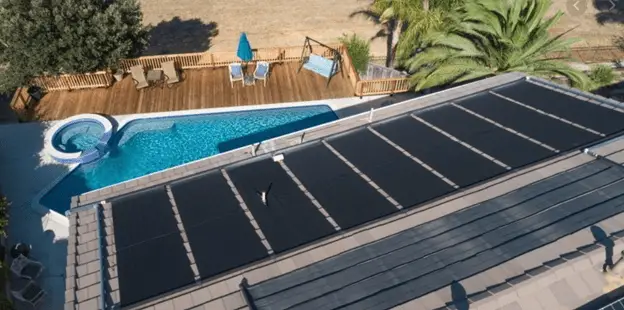
9. Using Solar Mats
Solar mats are used in the same way as solar panels. But unlike solar panels, solar mats get heat from the sunlight and heat the water that is passed through them. You will need a water pump as well. Solar mats are preferred for smaller swimming pools. Because, for a larger swimming pool, you will need to pump the whole water in solar mats to heat it properly. You will need solar mats of the same size as the pool. Let’s say you have a swimming pool of 6m x 6m, you’ll require solar mats of 6m x 6m to heat the pool.
Also, these mats require more installation than getting solar panels. You need to install a whole water pump and rig up your solar mat system.
Using solar energy for your use is eco-friendly as it will not use any fuel to heat your pool. But it will require a large space to place solar panels. These solar panels or solar mats are quite expensive which will result in a setback on your budget. As they are dependent on sunlight, using these solar devices will be useless in cloudy weather or winter.
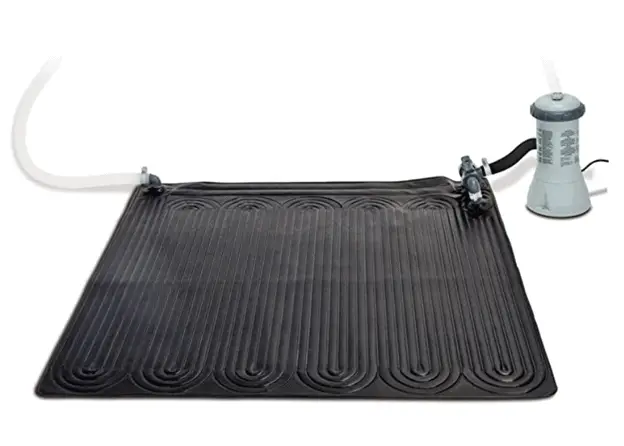
Using Electricity to Heat a Swimming Pool
Eco-friendly ways aren’t the only ways to heat a swimming pool. You can also use electricity for that purpose.
10. Using A Pool Heat Pump
A heat pump acts as solar mats but is not reliant on sunlight. It can be used in hot weather too as it only requires heat present in the air. A heat pump absorbs heat from the air and uses it to heat the water that is pumped inside. This water goes to the pool to warm it up. But as these pumps don’t generate on their own, they still need warm temperatures to work. These pumps can only work from April to October.
They are cost-efficient as they only need a one-time expense of installation. And only a water pump is used in them to heat the water. These pumps need to be placed in an open area to operate and won’t take much space.
In short, they are cost-effective, space-saving, easy to install, continuous, and can work all day. The only problem is, you can’t use them in the winter. This is not because of the efficiency of heat pumps that is lesser in lower temperatures, but also because they might be getting jammed or damaged.
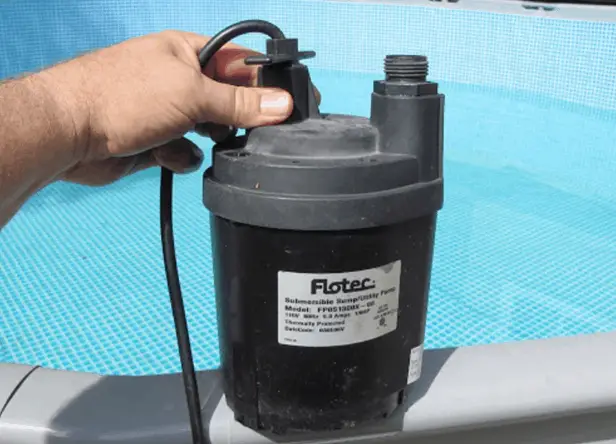
FAQs
1. How Can I Heat My Pool Fast?
To heat the pool fast, you can use two of the suggested ways that are a pool heat pump and solar cover simultaneously. The pool heat pump will heat the pool fastest. And the solar cover will keep the heat inside the pool and makes sure that it doesn’t go anywhere.
2. How Long Does It Take to Heat A Pool?
It depends on the size of the pool. If you have a small spa, it may take almost 1 hour to rise its temperature around 11°C or 20°F. But if you have a large pool, then it may take anywhere from 24 to 72 hours to rise its temperate to 11°C or 20°F.
You can use this formulation to calculate the time:
# of gallons in pool X 8.34 = ___________ lbs. of water
______ pounds of water / BTU Size = The hours it takes to raise the water temperature by degree F
3. Will Black Plastic Heat My Pool?
Yes, as black color is a great absorber of heat. You can use black PVC pipes, black plastic garbage bags, and even duct tape to heat your pool. But the preferred method would be to place large black plastic sheets on your pool. They will absorb the heat and you will get the warm water.
Conclusion
After going through all the methods about how to heat a swimming pool, we can say almost all of them are cost-efficient and surely heat your pool. But you have to remember, heating the pool is a tough business even for a heater. It holds innumerable gallons of water and takes 15-20 hours to heat it. The best and cost-efficient method can be using a pool heat pump. You can pair it with a solar cover to keep the heat in for a long duration.
Susan Racine
Saturday 25th of June 2022
Have over 20' of black PVC pipe running from filter to pool, goes through the back of my garage, then out to pool. Am thinking of using eavestrough heat tape and wrap around pipe? Have to run the filter anyway. Any comments?
Remodel or Move
Wednesday 21st of September 2022
With the help of eavestrough heat tape and wrap around pipe, you can save a lot of time and money.